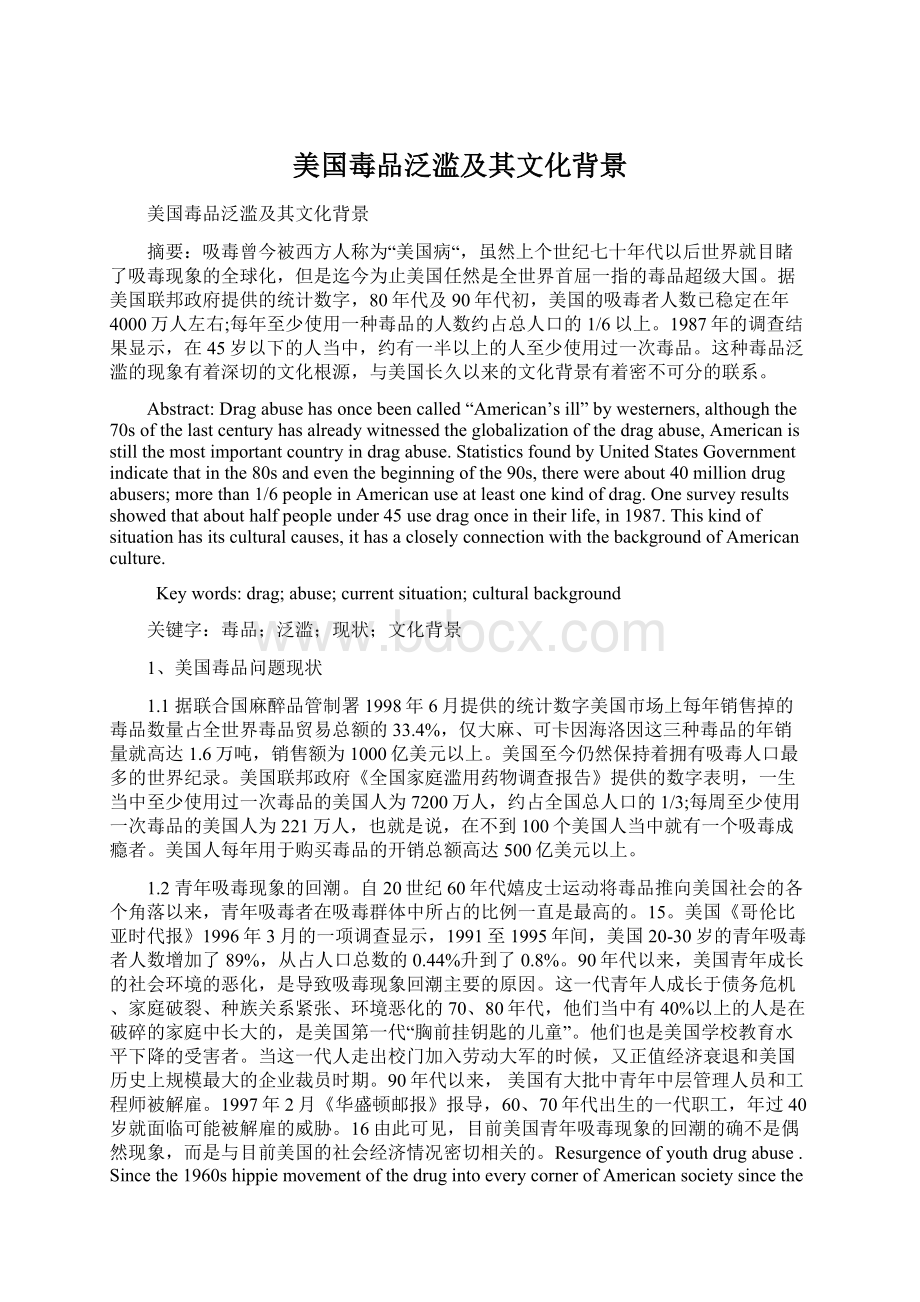美国毒品泛滥及其文化背景Word文档下载推荐.docx
《美国毒品泛滥及其文化背景Word文档下载推荐.docx》由会员分享,可在线阅读,更多相关《美国毒品泛滥及其文化背景Word文档下载推荐.docx(6页珍藏版)》请在冰豆网上搜索。

这种毒品泛滥的现象有着深切的文化根源,与美国长久以来的文化背景有着密不可分的联系。
Abstract:
Dragabusehasoncebeencalled“American’sill”bywesterners,althoughthe70softhelastcenturyhasalreadywitnessedtheglobalizationofthedragabuse,Americanisstillthemostimportantcountryindragabuse.StatisticsfoundbyUnitedStatesGovernmentindicatethatinthe80sandeventhebeginningofthe90s,therewereabout40milliondrugabusers;
morethan1/6peopleinAmericanuseatleastonekindofdrag.Onesurveyresultsshowedthatabouthalfpeopleunder45usedragonceintheirlife,in1987.Thiskindofsituationhasitsculturalcauses,ithasacloselyconnectionwiththebackgroundofAmericanculture.
Keywords:
drag;
abuse;
currentsituation;
culturalbackground
关键字:
毒品;
泛滥;
现状;
文化背景
1、美国毒品问题现状
1.1据联合国麻醉品管制署1998年6月提供的统计数字美国市场上每年销售掉的毒品数量占全世界毒品贸易总额的33.4%,仅大麻、可卡因海洛因这三种毒品的年销量就高达1.6万吨,销售额为1000亿美元以上。
美国至今仍然保持着拥有吸毒人口最多的世界纪录。
美国联邦政府《全国家庭滥用药物调查报告》提供的数字表明,一生当中至少使用过一次毒品的美国人为7200万人,约占全国总人口的1/3;
每周至少使用一次毒品的美国人为221万人,也就是说,在不到100个美国人当中就有一个吸毒成瘾者。
美国人每年用于购买毒品的开销总额高达500亿美元以上。
1.2青年吸毒现象的回潮。
自20世纪60年代嬉皮士运动将毒品推向美国社会的各个角落以来,青年吸毒者在吸毒群体中所占的比例一直是最高的。
15。
美国《哥伦比亚时代报》1996年3月的一项调查显示,1991至1995年间,美国20-30岁的青年吸毒者人数增加了89%,从占人口总数的0.44%升到了0.8%。
90年代以来,美国青年成长的社会环境的恶化,是导致吸毒现象回潮主要的原因。
这一代青年人成长于债务危机、家庭破裂、种族关系紧张、环境恶化的70、80年代,他们当中有40%以上的人是在破碎的家庭中长大的,是美国第一代“胸前挂钥匙的儿童”。
他们也是美国学校教育水平下降的受害者。
当这一代人走出校门加入劳动大军的时候,又正值经济衰退和美国历史上规模最大的企业裁员时期。
90年代以来,美国有大批中青年中层管理人员和工程师被解雇。
1997年2月《华盛顿邮报》报导,60、70年代出生的一代职工,年过40岁就面临可能被解雇的威胁。
16由此可见,目前美国青年吸毒现象的回潮的确不是偶然现象,而是与目前美国的社会经济情况密切相关的。
Resurgenceofyouthdrugabuse.Sincethe1960shippiemovementofthedrugintoeverycornerofAmericansocietysincetheyoungdrugaddictsintheproportionofthepopulationhasbeenthehighest.15.UnitedStates,"
ColombianAge"
asurveyinMarch1996showedthatbetween1991and1995,thenumberofdrugaddictsAmericanyouthaged20-30increasedby89percent,accountingfor0.44%fromthetotalpopulationroseby0.8%.Sincethe1990s,thedeteriorationofAmericanyouthgrowingsocialenvironment,arethemaincausesoftheresurgenceofdrugabuse.Thisgenerationofyoungpeoplegrowingupinthedebtcrisis,familybreakdown,ethnictensions,environmentaldegradation70,80ofthemhavemorethan40%ofthepeoplearegrowingupinabrokenfamily,wasthefirstAmericangeneration"
chestlatchkeychildren."
TheyarealsoAmericanschoolinglevelsfallvictim.Whenthisgenerationoutofschooltojointheworkforce,whentheyintheeconomicdownturnandthelargestcorporatelayoffperiodinAmericanhistory.Sincethe1990s,theUnitedStateshasalargenumberofmiddle-agedmiddlemanagersandengineersweredismissed.February1997"
WashingtonPost"
reportedthatthegenerationofworkersborninthe1960sand1970s,over40yearsoldmaybefacingthethreatofdismissal.16Thus,thecurrentresurgenceofAmericanyouthdrugabusedoesnotaccidentalphenomenon,butwiththecurrentsocio-economicsituationintheU.S.iscloselyrelated.
1.3吸毒低龄化趋势迅速发展。
吸毒人口趋向低龄化是美国吸毒问题的又一引人注目的新特点。
《哥伦比亚时代报》1996年3月进行的调查表明,1991-1995年间14-18岁的美国青少年吸毒人数不断增多,五年中增长了100%。
1992年,中学毕业生中有32.6%的人至少吸过一次大麻,而到1995年这个数字则上升到了41.7%。
另据美国全国家长禁毒委员会对高中毕业生(17-18岁)所做的调查,1995-1996学年,有29.5%的学生吸毒,而在1987-1988学年,这个数字则仅为18.6%,8年内增长了58.6%。
17导致美国吸毒问题低龄化的主要原因有二点,第一,近年来社会对校园毒品问题的重视程度有所下降。
由于美国没有对青少年的毒品犯罪规定刑事责任,贩毒分子利用这一点,常常高价雇佣青少年为他们贩毒。
全国性周报《高教纪事报》对全美831所学生人数超过5000人的大学所做的调查表明,因生产、使用和销售毒品而被捕的案件增加了23%,从1993年的4993起增加到了1994年的6138起。
18第二,美国40-45岁年龄段的中年家长们对毒品问题的态度有所转变主要表现为他们中的相当一部分人对自己的子女接近或尝试毒品普遍存在一种容忍态度,导致孩子们缺乏对毒品的警惕性。
总部设在洛杉矶的全美合作禁毒委员会对洛杉矶70所学校近6000名中学生的抽样调查显示,40%的洛杉矶学生相信,每个人都可以尝试毒品;
45%的学生表示他们将来有可能会尝试毒品。
该委员会主席詹姆斯·
布克认为:
“由于这种态度将会导致行动,不久的将来会有更多的年轻人加入吸毒者行列。
”Drugtrendofyoungeragerapidly.YoungeragepopulationtrendsofdrugabuseproblemintheUnitedStatesisanothercompellingnewfeatures."
ColombiaAge"
surveyconductedinMarch1996showedthattheUnitedStatesbetween1991and1995thenumberofdrugaddictsincreasingyoungpeopleaged14-18,anincreaseof100%infiveyears.In1992,32.6percentofsecondaryschoolgraduateswhohavesmokedatleastonceinmarijuana,butby1995thisfigureroseto41.7%.AccordingtotheNationalNarcoticsControlCommissionandtheparentsofhighschoolgraduates(17-18yearsold)surveydonebytheschoolyear1995-1996,29.5percentofthestudentdrugabuse,whileinthe1987-1988schoolyear,thisfigurewasonly18.6%,8anincreaseof58.6%duringtheyear.17resultedinayoungerageoftheAmericandrugproblemfortwomainreasons.First,thecommunityhasdeclinedinrecentyears,theemphasisonthedrugproblemoncampus.AstheUnitedStateshasnoprovisionsforjuveniledrugcrimescriminal,drugtraffickerstakeadvantageofthis,yo